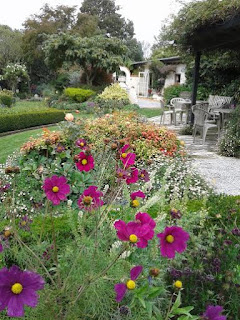Here we are still cutting back summer flowering perennials and annuals which have become long and lanky. Piles of soft plant matter go onto the compost but the stringy hard wood piles are dumped, a shredder would be good at this time because the more we can put back on the garden the more the garden benefits. I am leaving the hydrangeas to finish the wonderful autumn show they are offering right now, but have been taking some semi hard wood cuttings as I cannot get enough of these wonderful plants and it takes a few seasons for cuttings to grow into a good sized bush. Semi / hard wood cuttings need to be taken from close to the base of the stock plant, woodier cuttings are more likely to throw roots than shoots. Cut at a leaf junction, remove bottom leaves ( not too close to the stem) leaving a set of two leaves and the tip growth, remove the soft tip growth. Use a good nutrient free medium, river sand or pumice. Dip cuttings in rooting hormone to stimulate root growth then firm in and water, place in a shaded area over winter and Spring.
Still time for sowing seed under cover here on the coast and getting to prick out size before the days become really cold and growing stops. Once they are pricked out into punnets or pots they will need to be nursed through until spring. Sowing seed now gives you a head start and the seedlings carried through are much stronger and will do better than the new punnets of seedlings offered in Garden centers come spring. Seeds to sow under cover: Antirrhinum (snap dragon) dianthus, pansy, viola, poppy, scabious, sweet William, pollyanthas, primrose and primulas. Seeds to sow straight into the gardennow Alyssum, aquilegia, calendula, cornflower, lupins, sweet peas.
Lift gladioli and clean corms, after drying dust with flowers of sulpher before storing in paper bags, never plastic.
Peony roses: Do not disturb peony roses, just cut back dead tops and dispose of, if they need divided leave until spring.
Winter roses: will benefit from feeding now, take most shabby old leaves off because they harbour green fly over the cold months, but leave enough to protect the new growth. They can be removed when the flowers come up.
Tall asters: Any one growing tall asters should have had them flowering for a while. If they are falling all over the place and need support you need to remember to trim back the new growth by half at the end of next September, this will make them grow bushier rather than tall, I must remember to remind you then. Asters exhaust the soil as the clumps get bigger so divide often when finished flowering.
Lawns are slowing down now, I have given mine a dressing of dolomite lime to keep them sweet over winter, lime takes a season to work it's way down to do its job so if put on now the benefits will be had in spring. Lawn lime application corrects the PH balance in soil by neutralizing acidity and alkalinity. Fertilization of lawns causes the PH to become acidic, limestone will bring the Ph level back down to a natural balance. This has been the perfect Autumn for sowing a new lawn. If you notice patches of lawn Browning off and the birds showing interest and scratching grass out, you will probably have grass grub eating the grass roots, Grass grub start hibernating in May so this month is the very last chance you will have to deal to them. Grass grub granules need to be rained or watered in.
Vegetables: Watch pumpkins don't get frosted from now on, if they are big and sound hollow when you knock on them they can be picked and sat in a sunny place to ripen more. Anzac day is traditionally the time to plant broad beans, if you missed that day any time now is good.









